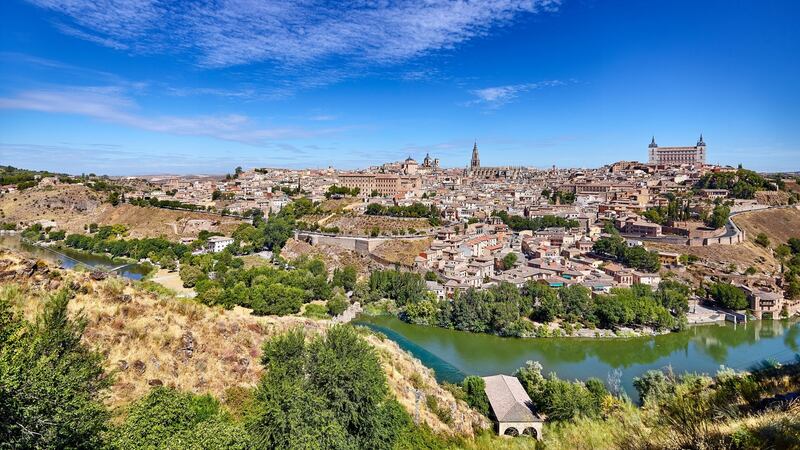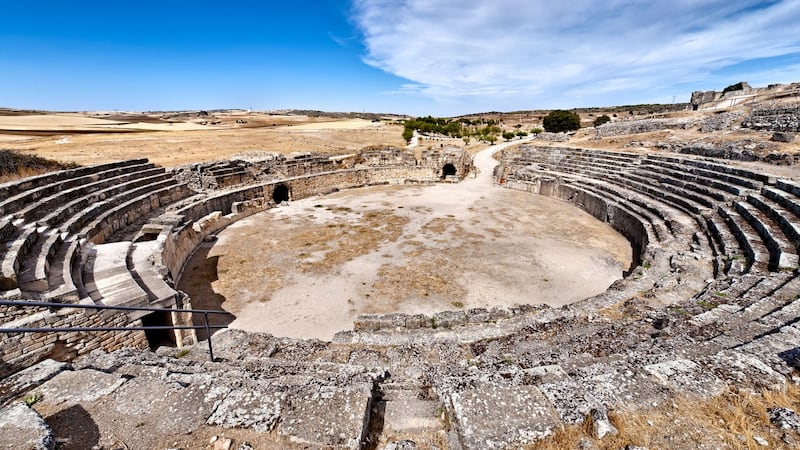Maintaining a sense of perspective was always going to be hard. After touching down on foreign soil for the first time in two years, I was sorely tempted to kiss the tarmac at Madrid airport in the fashion of Pope John Paul II. Throw in some proper T-shirt-and-shorts weather in mid-October and I was already riffing with headlines such as Spain’s plains reign.
Nevertheless, Toledo would impress in any circumstance. If ever there was a time to stand and stare, it was when we first saw the city in all its panoramic glory, from a viewing point across the river Tagus which loops around it on three sides en route to Lisbon, offering the natural protection that established it long ago as a citadel.
To my shame, apart from the expression Holy Toledo, possibly popularised by Batman and Robin, I knew nothing about this beautiful, intimate city, less than an hour by train or car south of Madrid, its successor as Spain’s capital. It is indeed a sacred place, a palimpsest of Christian, Muslim and Jewish traditions, whose legacy today is a wonderful and unusual melange of architecture accessed via a warren of winding, narrow streets. However, the renaming of buildings such as the 10th-century Mosque of Cristo de la Luz and the 13th-century Synagogue of Santa Maria de la Blanca leave one in no doubt as to which religion ended up the dominant one.
The cathedral, built in the High Gothic style from 1226 with some Mudejar or Iberian Muslim influences, is truly magnificent, replete with treasures such as local maestro El Greco’s masterpiece The Disrobing of Christ and a truly monumental monstrance. (In the interests of balance, however, there is a comically bad painting of a horse in the vestry that makes Donkey from Shrek look good.)
The El Greco museum nearby is a suitable shrine to the artist’s work. The Jewish quarter is also well worth a visit, especially the Sephardic Museum in the 14th-century Synagogue of El Transito, which tells the history of Jewish people in Spain. The carved wooden ceiling is inspiring.
Toledo is famous for its damascened or engraved metalwork and steel, so if you need a new set of knives or a sword, say, this is the place.
Several city gates survive, dating back as far as the 10th century, and the Alcántara Bridge, which dates back to Roman times, is awesome. A more modern alternative to crossing the Tagus is offered by Fly Toledo’s Tirolina urbana or urban zip-line. (I was saving myself for Cuenca’s famous high-wire bridge over the river Júcar, however).
We have a wonderful meal on a restaurant’s roof-top terrace overlooking the city, then a nightcap in a nearby bar. The city centre feels safe and relaxed, still lively after midnight but not rowdy.

Spanish tales
History is everywhere. The Puy du Fou theme park just outside Toledo hosts spectacular stage shows recounting classic Spanish tales such as El Cid but the lack of an English translation rendered it more entertaining than educational. Segobriga archaeological park, by contrast, provides English-speaking guides who walk you through the genuinely impressive remains of what was once a major Roman city, complete with theatre, amphitheatre, circus, forum, baths, aqueduct and necropolis, like an ancient ghost estate. Belmonte castle is another impressive site.
My favourite attraction, however, was undoubtedly Campo de Criptana, whose now iconic windmills inspired the famous chapter in Miguel de Cervantes' Don Quixote where our hero mistook them for giants and engaged them in battle.The whitewashed walls topped with black sails set on barren soil against a vast blue sky are incredibly photogenic.
We were also treated to a visit by an impressively mad-eyed Don Quixote and his long-suffering sidekick Sancho Panza, whose English-language double-act was impressive and entertaining. If you are of a shy disposition, however, stand back, lest you find yourself enlisted as a spear-carrier or mistaken for the Don’s love interest Dulcinea.

Must-see town
Cuenca is the region of Castile-La Mancha’s other must-see town. Famed for its hanging houses, perched on a hilltop – you can smell the scorched tyres of visiting drivers struggling with the vertiginous bends – overlooking the most gorgeous of gorges, with an artificial sandy beach, it is Spain’s fourth-highest town, made rich by wool in the Middle Ages, which accounts for the magnificence of its architecture.
It has a wonderful modern art museum, the Museo del Arte Abstracto. Sadly the rather terrifying bridge over the gorge to our parador is closed after a landslide so I must walk down and back up instead. I pause to listen to a busker’s beautiful flamenco guitar, but mostly to get my breath back.
The country has been hard hit, like Ireland, by rural depopulation, known as la España vaciada, or “empty Spain”, but this region appears less affected, the towns bustling with nightlife, the countryside full of olive groves and vineyards.
We visit two immaculate vineyards, Bodegas Mont Reaga and Finca la Estacada, where we sample the local produce and make the most of our check-in baggage allowance. I would not perhaps have had such a large lunch if I had known there would be jamon iberico and herb-infused manchego to accompany the wine but mercifully they were wafer-thin.
Is there a greater feeling of serenity to be had than wine-tasting outdoors as the sun sets over vines stretching to the golden horizon? Our guide is reciting the wine regions of Spain like a litany of saints or a Friel character remembering the names of townlands. I feel right at home.
HOTELS Hotel Boutique Adolfo, Toledo
A fine, four-star hotel, named after its owner, local celebrity chef Adolfo Muñoz, which overlooks the pretty central square Plaza Zocodover.
Hotel Palacio del Infante Don Juan Manuel, Belmonte
A former monastery, the hotel is very grand, with a glazed-over courtyard at its centre, and a curious miniature village exhibition.
[ Parador de CuencaOpens in new window ]
Overlooking the town centre from the other side of the gorge, it’s a thing of beauty itself, part of Spain’s national network of upmarket paradors.
RESTAURANTS
Teraza Azotea de Carlos V, Toledo
As well as a fabulous panoramic view of Toledo, this place does a mean cocktail and the food is first rate.
Las Musas, Campo de Criptana
Windmill-tilting is hungry work. Food fit for a Don. The lamb is superb. The three-course lunch for €16.50 a steal.
Raff San Pedro, Cuenca
Great regional restaurant owned by chef José Ignacio Herráiz, a native of the town whose CV includes a stint at El Bullí
[ Finca La EstacadaOpens in new window ]
An upmarket vineyard with indoors and outdoors dining. Lunch was top-drawer, the patatas the most bravissimas I have ever tasted. Even the cheaper vintages are excellent. A good place to stock up on wine and olive oil.











